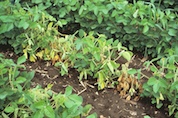Wisconsin Soybean Phytophthora Root Rot Survey Update
Anette Phibbs, Plant Pathologist with the Wisconsin Department of Agriculture and Consumer Protection, reports that the 2014 survey of early vegetative soybeans shows high levels of Phytophthora root rot disease caused by Phytophthora sojae. Nearly half of soybean fields sampled from June 6 to July 16 in 35 surveyed counties were infected with this fungus-like pathogen. Lab testing of root samples showed 26 out of 53 (49%) fields tested positive for P. sojae. Fields that tested positive were found in the following 15 counties: Barron, Clark, Dane, Green, Jefferson, Kenosha, Lafayette, Manitowoc, Marathon, Ozaukee, Rock, Sheboygan, St. Croix, Walworth, Winnebago. Counties were the problem was not encountered should not expect to be free from the disease. This is the highest prevalence of soybean root rot since the start of this survey in 2008. During the flood prone spring of 2010 the pest survey team found 38% of fields infected. This high prevalence of Phytophthora root rot throughout the surveyed area is no doubt due to heavy rainfalls causing saturated soils and relatively low temperatures this spring which have been very conducive to this water mold. A relatively new Phytophthora species, P. sansomeana, was detected in soybean roots in Calumet, Dunn and Eau Claire Counties. This pathogen was first detected in Wisconsin soybeans in 2012 in Jefferson, Marathon and Sheboygan counties; again in 2013 in Dane, Green, Outagamie and Sheboygan counties. Research into P. sansomeana’s potential effect on soybean and corn are ongoing.
For more about Phytopthora root rot of soybean, visit an informational webpage by clicking here and scrolling down to “Phytophthora Stem and Root Rot” or download a UWEX fact sheet by clicking here. Specific questions can be directed to Damon L. Smith, Field Crops Extension Pathologist, University of Wisconsin-Madison at dlsmith26@wisc.edu.



